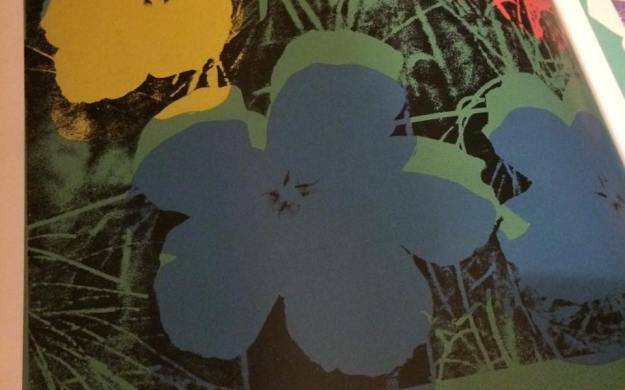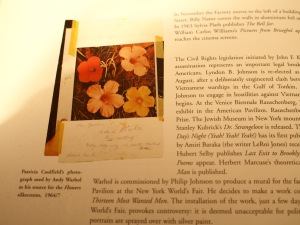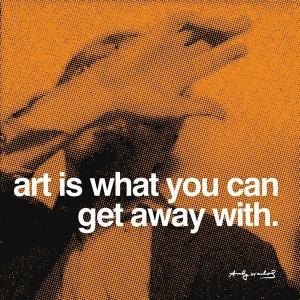Sources visited:
www.eykynmaclean.com/exhibitions/andy-warhol-flowers
www.warhol.org/ArtCollections.aspx?id=1572
www.sothebys.com/en/news-video/videos/2013/10/Floral-Fantasy.html
www.gallerywarhol.com/andy-warhol-flowers-1964-FS-II.6.htm
https://www.moma.org/learn/moma_learning/themes/pop-art/appropriation
http://www.moca.org/pc/viewArtTerm.php?id=2
http://www.tate.org.uk/learn/online-resources/glossary/a/appropriation
http://arthistory.about.com/od/glossary_a/a/a_appropriation.htm
http://revolverwarholgallery.com/andy-warhol-art-appropriation/
http://www.goodreads.com/quotes/45836-art-is-what-you-can-get-away-with
http://farrells.people.cofc.edu/Farrell/Warhol/English/Web%20Site/Main_page.html
I chose to look at Warhol’s Ten-Foot flowers because they are an everyday object. He used many everyday objects in his work but I feel this one is very beautiful and is a little different from the Campbell’s soup cans, Coca-Cola bottles and Marilyn because flowers are apart of nature – they are precious.
‘The square format allowed Warhol complete freedom with orientation. For the first time, his works had no fixed upright, allowing the Flowers to be installed in a variety of ways. Another unique aspect to this series is the different techniques and media he explored, including silkscreen, pencil, hand painted acrylics, and fluorescent Day-Glo paint.’
‘Unlike Warhol’s work prior to this point – which drew upon images in the mass media as well as commercial brands – Warhol turned to a different source: a spread in a magazine called Modern Photography. The magazine’s June 1964 issue featured a photograph of seven hibiscus flowers taken by executive editor Patricia Caulfield, printed three times in a glossy foldout to show the color variation of different chemical processes. The serial format undoubtedly appealed to Warhol’s sensibility. To create the composition for his paintings, he cropped Caulfield’s photograph into a perfect square, manipulating the flowers so that four of the original seven fit into this new square format. His unauthorized use of another artist’s photograph, however, landed him in trouble when Caulfield brought suit in 1966 (they settled out of court). From this time on, Warhol based his art on photographs he took himself.’

Andy Warhol, Flowers, 1964. © 2012 The Andy Warhol Foundation
for the Visual Arts, Inc./Artists Rights Society (ARS), New York.

Flowers, 1964
acrylic, silkscreen ink, and pencil on linen
80 7/8 x 81 in. (205.4 x 205.7 cm.)
“With the Flowers, Andy was just trying a different subject matter. In a funny way, he was kind of repeating the history of art. It was like, now we’re doing my Flower period! Like Monet’s water lillies, Van Gogh’s flowers, the genre.” (Gerard Malanga as cited in A Year in the Life of Andy Warhol, New York 2003, p. 74).
‘The simplicity of the image, bright and flat, meant that these instantly accessible paintings were easy to serialize. Warhol had declared his wish to be a machine and to remove himself as much as possible from the artistic process and from the work of art itself.’
Here is the original image he used by Patricia Caulfied:
‘Appropriation is the intentional borrowing, copying, and alteration of preexisting images and objects’
As Warhol stated, “Pop artists did images that anyone walking down the street would recognize in a split second—comics, picnic tables, men’s pants, celebrities, refrigerators, Coke bottles.”
To appropriate is to borrow. Appropriation is the practice of creating a new work by taking a pre-existing image from another context—art history, advertising, the media—and combining that appropriated image with new ones.
- ‘Warhol isolated the image of these products to stimulate product recognition (just like in advertising)’
- ‘While he transformed the image by transferring it onto screenprints and canvases, the image used as a stencil was not legally his. He owned the rights to his artwork, but not to the image that the art was dependent on.’
- ‘Similarly, he “borrowed” the logo from Campbell’s Soup cans, but repurposed it by applying it to canvases and screenprints. Wary at first about the blatant use of their classic logo, the company soon realized that the free publicity was rewarding.’
- ‘In 1966, he became the subject of a lawsuit brought on by photographer, Patricia Caufield for the use of her photos of hibiscus flowers. The suit was settled out of court, but as a result Warhol decided that he would rather use his own images when he could, which inadvertently launched him into experimenting with a new medium — photography.’
“Art is what you can get away with.” – Andy Warhol



